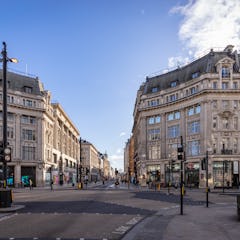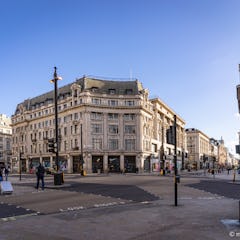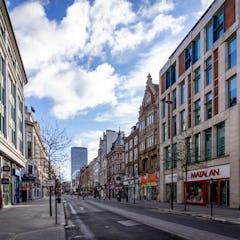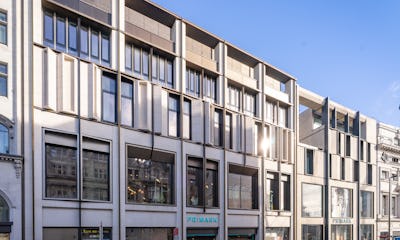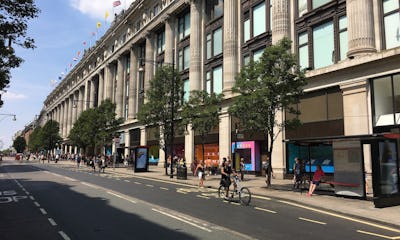History of Oxford Street – From Roman Road to Shopping Hub
Although today Oxford Street is known as a bustling shopping street, its roots go far deeper. Originally part of the Roman road Via Trinobantina, it connected London with routes to the west. In the Middle Ages, the road was known as Tyburn Road.
During the 18th century, the street shifted from residential areas and workshops to a more commercial role. Shops and entertainment venues appeared, and it was renamed Oxford Street, referring both to the city of Oxford and the lands of the Earl of Oxford. The Harley family, who held the title, also left their mark on many surrounding street names.
The early 20th century brought the opening of major department stores, including Selfridges in 1909, cementing Oxford Street’s reputation as London’s prime shopping district. Despite bomb damage during WWII, the area was rebuilt and modernised. In the 21st century, Oxford Street has continued to evolve with pedestrian-friendly improvements, reduced traffic, and a new generation of flagship stores.
Oxford Street Today – Shopping Meets City Life
Oxford Street is more than just a shopping destination. Historic department stores stand side by side with global brands, while new pedestrianisation projects are reshaping the street with a plan to start between Marble Arch and Oxford Circus and further extends towards Tottenham Court Road. Wider pavements, new planting and resting areas aim to make Oxford Street a greener, more pleasant space that combines retail with leisure and cultural experiences.
Iconic Department Stores
There are several department stores on Oxford Street. The main ones are John Lewis, Marks & Spencer and Selfridges.
John Lewis was opened in 1864, rebuilt after WWII, and now the flagship of the John Lewis chain. Marks & Spencer was founded in 1884, and now operates two stores on Oxford Street offering clothing, homeware and food. Selfridges, named words best department store four times, opened in 1909 and transformed shopping in London with its innovative window displays, experiential retail and wide product range.
International Fashion Brands
Oxford Street is home to over 300 stores, including major international fashion chains, and there should be something for everyone. Zara offers fast fashion for women, men and children, with a growing focus on sustainable textiles such as Infinna fibres. H&M offers affordable fashion with in-store recycling points, aiming for all materials to be recycled or sustainably sourced by 2030. Primark is famous for huge selections and low prices, and its Oxford Street megastore is a tourist attraction in its own right. UNIQLO is a Japanese retailer known for minimalist basics and technical ranges like Heattech and AIRism, with strong sustainability initiatives.
Sports Flagships – Nike & Adidas
There are also stores for sports clothing. Nike Town features sustainable collections such as Space Hippie and Flyknit, part of Nike’s Move to Zero programme. The Adidas Flagship store showcases products made in collaboration with Parley for the Oceans using recycled ocean plastic.
POP MART – Asian Collectibles Arrive in London
POP MART, the Chinese collectibles brand, has opened one of its first European flagships on Oxford Street. Known for blind-box figurines such as Molly, Skullpanda, Dimoo and Labubu, POP MART attracts younger audiences and travellers looking for unique finds. You’ll often find a long queue outside the store.
Culture and Experiences Near Oxford Street
Oxford Street also offers culture beyond shopping. Outernet London near Tottenham Court Road offers immersive digital exhibitions and giant LED walls. It is a nice place to stop and enjoy the often-changing exhibitions.
Twist Museum has interactive illusions and optical effects and is popular for families and photo moments.
The Fashion Space Gallery, which is linked to the London College of Fashion, featuring exhibitions on fashion and art.
MOCO Museum is a museum for modern art including Warhol, Basquiat and Banksy, and is located near Marble Arch.
Frameless Immersive Art offers a new way to enjoy art using multimedia art projections bringing classics to life, also near Marble Arch.
Tips for Visiting Oxford Street
Here are some tips to make your visit more enjoyable:
- Avoid peak crowds: Weekends and sale periods can be extremely busy. Weekday mornings are quieter.
- Wear comfortable shoes: The street is long, and many visitors combine it with nearby areas like Mayfair and Soho.
- Sunday hours: Department stores open from 12 noon.
Summary
Oxford Street is much more than a shopping street. It is the commercial heart of London and one of the city’s most famous landmarks. Its history stretches back to Roman times, but today it is known for its department stores, flagship fashion brands and cultural attractions. With ongoing pedestrianisation, Oxford Street is becoming an even more inviting urban space that blends shopping, green areas and cultural experiences.




